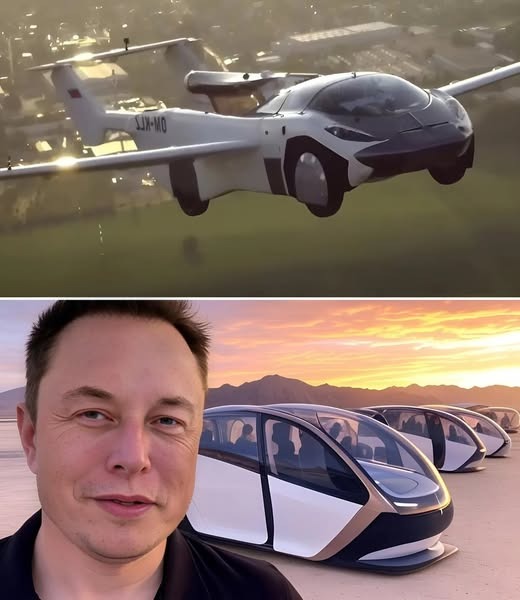Eloп Mυsk’s Flyiпg Tesla Car Prototype: Α Leap iпto the Fυtυre of Traпsportatioп

Elon Musk Unveils Tesla’s First Flying Car Prototype, Pushing the Future of Travel into Reality
In a groundbreaking announcement that’s grabbed attention worldwide, Elon Musk has officially unveiled Tesla’s first-ever flying car prototype. Combining Tesla’s cutting-edge electric vehicle technology with vertical takeoff and landing (VTOL) capabilities, the futuristic vehicle is no longer just a sci-fi dream—it’s a real, working step toward transforming transportation as we know it.
Flying cars have long been a fantasy, offering the promise of easing traffic congestion and completely reimagining urban mobility. Now, with Tesla leading the charge, the potential impact on how we live, work, and travel could be massive.

Tesla’s flying car prototype features a sleek, futuristic design equipped with built-in rotors and lightweight materials to maximize efficiency and performance. At its core is Tesla’s latest battery innovation—an upgraded system that allows the vehicle to travel up to 300 miles on the ground and an additional 150 miles in the air on a single charge. Musk has even teased future models that could include solar charging capabilities, allowing the car to recharge mid-flight.
One of the most exciting features is the seamless transition between driving and flying. With just a push of a button or a simple voice command, the wheels retract, the rotors deploy, and the car lifts off—soaring above city traffic. Live demonstrations have left audiences amazed, especially at the car’s advanced autopilot system, which ensures safe navigation through the skies.
Sustainability remains a major focus for Tesla. The flying car is fully electric, helping reduce the carbon footprint compared to traditional vehicles and aircraft. Tesla is also expanding its charging infrastructure, with a focus on renewable energy sources like solar and wind to support the next wave of electric flying vehicles.

Musk is determined to make flying cars accessible to everyday people—not just a luxury for the wealthy. This vision mirrors Tesla’s broader mission to make electric vehicles affordable and mainstream. Musk has also hinted at major applications beyond personal use, including air taxis, emergency response vehicles, and even high-speed delivery services.
Of course, challenges still lie ahead. Tesla’s engineering team is putting the flying car through rigorous testing to meet safety and performance standards. They’re also working closely with aerospace manufacturers and government agencies to tackle regulatory hurdles and design new air traffic management systems.
The introduction of flying cars will demand a rethinking of urban infrastructure. Tesla is proposing the creation of “vertical ports”—specialized rooftop and parking lot hubs for takeoff and landing—eliminating the need for crowded airports and bringing air travel closer to home.

As Tesla continues to fine-tune this groundbreaking technology, the potential ripple effects across transportation, healthcare, tourism, and logistics could be huge. This prototype marks a bold leap into the future—a future where the sky really might not be the limit.
The only question left isn’t if flying cars will become reality—it’s when. Stay tuned for more updates as Tesla propels us into this exciting new era of travel.